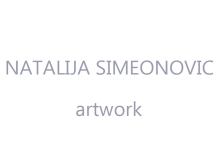A⁄PART⁄NESS – Jelena Krivokapic
tekst na spskom: Jelena Krivokapić “O-dvojenosti”
 Art info link
Art info link
New age ideas that support the pursuit to recreate the ideas of the integral (the alchemist book: Atlanta Fugiens by Michel Maier, 1618) by combining the power of magic and art embody some of the concepts that contemporary thinkers and artists often evoke in their opuses. Brought to life not so much in the context of Utopias of Original Harmony as in their demand for the creation of the new Integral Order of Intimacy – this contemporary recreation of the idea of the integral is developed within the habitus of creative thought and active potential of everyday rituals that are, in that sense, shared by the members of one community and that would only gradually change them (Hakim Bey, Palimpsest). The initial backbone of the artist’s exploration and the exhibition titled AlPARTlNESS E testifies the collision that takes place on these qualitatively different demands in anticipation of an apologetics of the everyday based on the creative dynamics of the couple and the “ negotiations” of their gender parities in regards to the inherited representations of their traditionally conceived and lived divisions and roles.
The conceptual aspect of the work develops on the level of expropriating an existing sample from the past – Maier’s alchemist book Atlanta Fugiens[1] and decoding it structurally. The artist first takes the graphic emblem number 30 – representing a man and woman as Sol and Lune and their textual companions, the constitutive alchemical attributes of the pairs of opposites: chicken – rooster, mercury – sulfur, silver – gold, water – fire, earth – sky. If the configuration of these elements seen on the historical composition foretells the virtual threshold of the completed alchemical experiment and its “distillate” in the hypothetical dualist coupling of the pair into an ideal androgen being, as could be seen in the following emblem of the book, the artist’s original interpretation of these elements creates an open meta-structure of discourse on the life of the pair and the emancipation of their dualist natures.
By formally deconstructing the existing composition and the reintegration of its fragments into series of individual panel paintings of identical size (70×185), the artist replicates the position of the contemporary artist as a shaman or alchemist caught in the act of producing a series of experimental alchemic retorts: “The beginning of leafing through the original engravings was like moving the hands of the clock in the opposite direction. Firstly the male and female figures were separated in the form of prints in a format that are in proportion to the human body. Stencils were then made from the taken elements that were recomposed within the “male” and “female” symbols. By fragmenting and destroying the basic forms, the focus was turned to the facture of the painting and its materiality with the aim of achieving an ambient quality. The oneness of space of the painting itself was however sacrificed in favor of dislocating it into the unified plane of a gallery exhibit.
The transcendentality of the golden or blue color is firstly arbitrated on the isolated panels in contrast to the emulated alchemical pairs of opposites – the sun and moon, the male creative principle and the female fertile mold and recipient. This color division is “contaminated” by the constellation of elements of the heavenly bodies, atmospheric sediment, parts of mechanical contraptions or fragmented anthropological limbs, a series of multiplied forms in the act of uncontrolled semantic dislocations and burgeoning. This is the place where the male and female “nature” is about to be produced by artistic mean. They appear within the scope of constant friction and antagonism of their own temporary mandates: the sensual color and non-color, the transcendental material and its “cooled off” painted rasters, as an act of painting seen in its mechanical replicas of anonymous prints or its revival auraticity of the vanished presence, in the negotiable balance between the horizontal perspectives image regime and their constant abolitions into the plunging vertical planes. The original iconic representation of antagonism between the pairs of opposites on the series of newly created compositional panels made by Natalija Simeonovic recreate the game of their constant positioning in the relationship as examples of ideal parities by a syntax of cuts and stops, aesthetics of deformation and trick drawings a between the acts post baroque drama based on the changeable status of nature in culture, a syncretism of romanticist images of an idyll as a counterpoint to family drama and crime of passion.
When interpreting each culture and its linguistic structures of upmost importance is, as we could seen, the critical stand the researcher and the artist take towards the existing languages of opposites and the antagonisms that have defined the poles and opposition pairs. Although the phenomena on which the origin, dynamics of development, as in the final instance the control of a society is based, this tendency of creating dichotomies in One or a whole order of isolated pairs of opposites will primarily represent an systematic act of an individual articulating his/her own identity and an optimal consensus it “negotiates” for remaining in an equilibrium with himself/herself and the world around him/her.
[1] Opus Atlanta Fugiens – or The Philosophical Emblems of the Secrets of Nature (1618), was conceived as a multilayered art book that incorporates the visual arts, literature and music in 50 integral multi scoress of music similar to today’s intermedial procedures seen in the works of contemporary artists. The philosopher’s textual and pictorial embletic solutions present coded instructions for a series of alchemical processes (the quest for the “philosopher’s stone”) where the viewer, the initiated individual is invited to take part in an act of continual spiritual advancement and transcendence of his/her material nature.
http://www.artinfo.co.rs/ceo_profil.php?korisnik_id=1029#info_81

